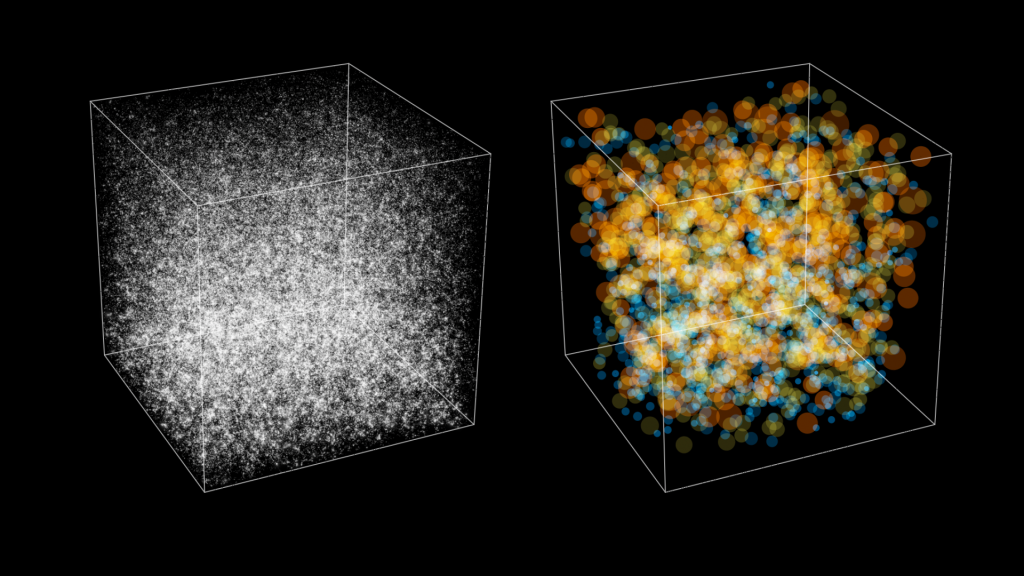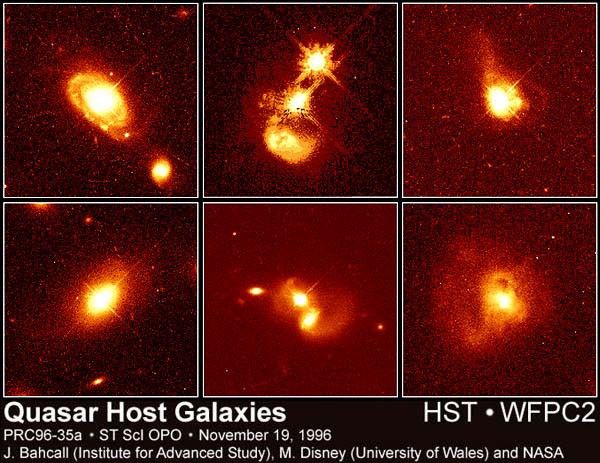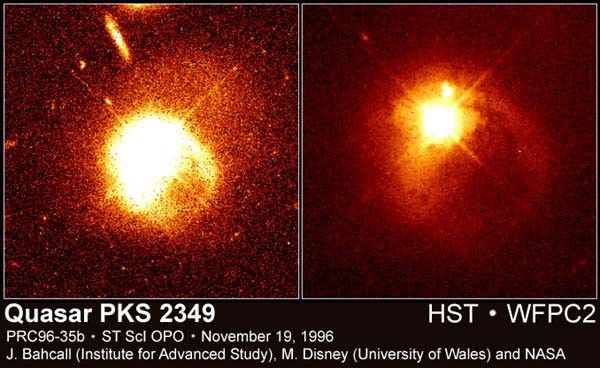Two teams of astronomers are releasing dramatic Hubble Space Telescope images today, which show that quasars live in a remarkable variety of galaxies, many of which are violently colliding. This complicated picture suggests there may be a variety of mechanisms - some quite subtle - for "turning on" quasars, the universe's most energetic objects.
The Hubble researchers are also intrigued by the fact that the quasars studied do not appear to have obviously damaged the galaxies in which they live. This could mean that quasars are relatively short lived phenomena which many galaxies, including the Milky Way, experienced long ago.
John Bahcall of the Institute for Advanced Study, Princeton, NJ, emphasizes that Hubble's clarity opens a complicated picture. "If we thought we had a complete theory of quasars before, now we know we don't," says Bahcall. "No coherent, single pattern of quasar behavior emerges. The basic assumption was that there was only one kind of host galaxy, or catastrophic event, which feeds a quasar. In reality we do not have a simple picture - we have a mess."
Mike Disney, University of Wales College, Cardiff, U.K., who is leader of the European team, says, "People had suspected that collisions might be an important mechanism for feeding black holes and generating the vast amounts of energy emitted by quasars. Now we know they are and we didn't know that before Hubble. This is a really exciting achievement."
Though a number of the images show collisions between pairs of galaxies which could trigger the birth of quasars, some pictures reveal apparently normal, undisturbed galaxies possessing quasars. "We were amazed by the beauty and clarity of the Hubble images, as well as the diversity of quasar environments," says Donald Schneider of Pennsylvania State University, University Park, PA.
Discovered only 33 years ago, quasars are among the most baffling objects in the universe because of their small size and prodigious energy output. Quasars are not much bigger than Earth's solar system but pour out 100 to 1,000 times as much light as an entire galaxy containing a hundred billion stars.
A super massive black hole, gobbling up stars, gas and dust, is theorized to be the "engine" powering a quasar. Most astronomers agree an active black hole is the only credible possibility that explains how quasars can be so compact, variable and powerful. Nevertheless, conclusive evidence has been elusive because quasars are so bright they mask any details of the "environment" where they live.
"These problems couldn't be solved without the Hubble Telescope," Disney said. "I gave up on studying quasars 20 years ago, because I realized we had to wait for a space telescope to provide a clear enough view for solving mysteries."
Observations by the European team, using the Wide Field Planetary Camera 2 (WFPC2) in high-resolution mode, reveal that quasars appear to be born in environments where two galaxies are interacting violently and probably colliding. "This had long been suspected as a mechanism for igniting a quasar but no one knew whether the idea was really right, before the Hubble," says Peter Boyce of the European team.
"In nearly every quasar we look at we clearly see one galaxy apparently swallowing another," Disney said. He selected three quasars known to be strong infrared emitters, suggesting that they might be in spiral galaxies, which typically contain an enormous amount of gas and dust. "When we image them with Hubble we see the most colossal smashups, where two giant spiral galaxies like our own Milky Way have crashed head on into one another and flung off pieces violently in all directions. Some of those bits seem to have finished up in the nucleus of one of the spirals where there is probably a giant black hole feeding on it."
Bahcall, Schneider and Sofia Kirkahos also used the WFPC2, but in wide-field mode, to survey 20 quasars. Bahcall finds about half of the quasars studied have host galaxies which look undisturbed. "Either the interacting companion is very close to the nucleus and below Hubble's resolution, or other mechanisms are at work in igniting quasars."
Both teams agree that Hubble images do show conclusively:
- That most quasars lie at the cores of luminous galaxies, both spiral and elliptical. Though underlying galaxies were suggested in ground-based quasar observations, astronomers had to wait for Hubble's capabilities to show the host galaxies clearly enough for astronomers to begin to classify their shapes.
- Interactions between galaxies, either through direct collisions or near encounters, can be important in "turning on" a quasar, by dumping fuel onto a black hole. However some quasars look unperturbed, so there may be other, more subtle mechanisms for feeding the black hole. "Some of the galaxies we observed don't appear to know they have a quasar in their cores," says Bahcall. "This may be a very important clue, since it was a completely unexpected result."
- Quasars that are "radio quiet" are often in elliptical galaxies, not always in spiral galaxies, as previously believed.
Further quasar research will be challenging because of the great distance and long time scales involved. "It's like having a few still shots of a football game and trying to decipher both the rules and the final score. It's very challenging, and great fun, but you are obviously open to making the most dramatic mistakes. We'll get there in the end but we may need a lot of Hubble pictures to be certain what is going on," Disney said.
Now that more is known about the environments in which quasars exist the teams emphasize astronomers must address even larger puzzles. Do most quasars flare up for a brief period of a galaxy's life (100 million years or less)? If so, then most galaxies, including our Milky Way, could be "burned out" quasars. If, alternatively, quasars are long-lived, it implies they are more rare. "This means a few extremely massive black holes formed very early in the universe," says Disney.
Astronomers also need to address a "chicken and egg" problem about the birth of quasars. Did the massive black holes form first and the galaxies formed around them, or did galaxies precede black holes, which quickly grew in their cores though stellar collision and merger?
Advanced instruments planned for Hubble should also help pin down more details. The Near Infrared Camera and Multi-Object Spectrometer (NICMOS), to be installed in 1997, and the Advanced Camera, to be installed in 1999, will have coronagraphic devices which will block out the glare of a quasar, allowing astronomers to see closer into a galaxy's nucleus. By viewing galactic structures in infrared light, the NICMOS should be able to provide important new details about the host galaxies of quasars.
BACKGROUND INFORMATION: QUASARS – "THE LIGHT FANTASTIC"
Quasars have been so elusive and mysterious that the hunt to define them would have taxed even the superior analytical skills of detective Sherlock Holmes.
Since their discovery in 1963, astronomers have been trying to crack the mystery of how these compact dynamos of light, which lie at the outer reaches of the universe, produce so much energy. Quasars are no larger than our solar system but outshine galaxies of hundreds of billions of stars. These light beacons have left trails of evidence and plenty of clues, but scientists have only just begun to understand their behavior.
For centuries, quasars went undetected, appearing in the sky as faint stars. No one suspected anything more. In the 1940s, however, radio scientists discovered that celestial objects emitted radio waves, giving birth to radio astronomy.
Soon astronomers began examining the sky to find as many objects as possible that radiated radio waves and tried to link them to optical objects. Their search led to several radio sources whose positions coincided with blue starlike objects.
Astronomers Allan Sandage and Thomas Matthews attempted to uncloak these mysterious objects in 1960. They were puzzled to find a strange source of radio emission that, in visible light, looked like a faint star. But this object was emitting more intense radio waves and ultraviolet radiation than a typical star.
In 1962 British radio astronomer Cyril Hazard took a crack at solving the mystery. He had an ingenious method of using the moon as a marker to pinpoint a radio source. When the moon would pass in front of a particular radio source (called an occultation), he noted the precise instant the radio signal stopped and then reemerged.
But he almost didn't get the opportunity to record the information. Hazard was at the University of Sydney and had arranged to make the observation at Parkes Radio Telescope, located several hundred miles away in the Australian outback. The night the occultation occurred, Hazard took the wrong train and missed the observation. Luckily, observatory director John Bolton and other astronomers made the observation. But Bolton also had his own problems. He couldn't tip the telescope over far enough to record the observation. So, he cut down a bunch of trees. Then he removed the telescope's safety bolts and tilted the several thousand ton telescope over enough to catch the occultation.
The astronomers observed a radio source that could be traced to a single starlike object, then known as 3C 273, in the constellation Virgo. Although this object looked like an ordinary star, it exhibited peculiar behavior. The object was emitting a tremendous quantity of radio signals. An optical analysis of the object's spectrum was unlike anything previously encountered.
What was it? In 1963 Maarten Schmidt at Mount Palomar observatory deciphered the code. The spectrum contained a few strange wide emission lines, which at first seemed pretty confusing. Schmidt soon realized he was looking at normal spectral lines for hydrogen. The lines, however, were shifted toward the red end of the visible spectrum, making them almost unrecognizable. There was only one explanation: This object was receding away from Earth at almost 30,000 miles per second, which meant that it was 3 billion light-years away. Astronomers quickly dubbed the objects quasi-stellar radio sources.
"Once Maarten Schmidt cracked the safe, all of a sudden things began to fall into place," says John Bahcall, who was a young physics professor at Caltech when Schmidt made his discovery.
Now the hunt was on to define these objects. How were they formed? What fueled them? Do they reside in galaxies? How can such tiny objects only a few light-months across emit so much radiation?
"Hunting for quasars became a major sport," says astronomer Mike Disney, who decided to become an astronomer after reading a story about the discovery of quasars. "It was an exciting thing. Clearly, it was a new physical phenomenon."
Astronomers rushed to discover more of these objects. Since then, thousands of them have been identified. Sandage found quasars that don't emit any radio waves. These "radio quiet" quasars now comprise about 99 percent of the population.
Theories also abounded about the nature of these objects. One theory questioned the definition of red shift, the measure of an object's recession velocity. The farther away an object is, the longer and hence redder the wavelength. Maybe quasars - which had high red shifts because they were far away - weren't so far away. Perhaps red shift is a measure of something else. But most astronomers quickly rejected this theory.
Russian scientist Yakov Zeldovich proposed yet another theory, which astronomers still believe today: Black holes provide the power that turns on quasars. A black hole is created when a giant star collapses to a tiny point of infinite density. Astronomers believe that a quasar turns on when a black hole at a galaxy's core feeds on gas and stars. As matter falls into the black hole, intense radiation is emitted.
Astronomers were making considerable progress towards explaining quasars, but there still were many questions they couldn't answer. Quasars were so bright that they drowned out everything around them. What objects were near quasars?
Did quasars reside in galaxies? Ground-based telescopes didn't give astronomers many clues. Some ground-based images hinted that quasars reside in galaxies, but astronomers couldn't see the surroundings clearly.
Finding the answers to many pressing quasar questions was a major reason for the push for a space telescope. Bahcall was a principal advocate for the telescope, telling Congress in 1978 that "one needs to observe quasars with the space telescope to find out whether or not these bright point-objects, quasars, are surrounded by fainter, more diffuse light of galaxies."
Bahcall was right. Spectacular images from the Hubble Space Telescope have shown that quasars indeed reside in galaxies. But the images have revealed other surprising information: Quasars live in a variety of galaxies. Some galaxies are quite normal, others are colliding with their neighbors.
Although Hubble has yielded more clues, many questions still remain unanswered about these enigmatic objects.
"I'd like to know what turns on a quasar," Bahcall says. "We've got some clues, but not definitive answers."
Disney wants to figure out whether quasars are "light bulbs or lighthouses. We don't know if they are pointing their energy at us or pointing it in all directions. And how long are they turned on? Are they short-lived or long-lived? We're only just getting some ideas to these questions."































